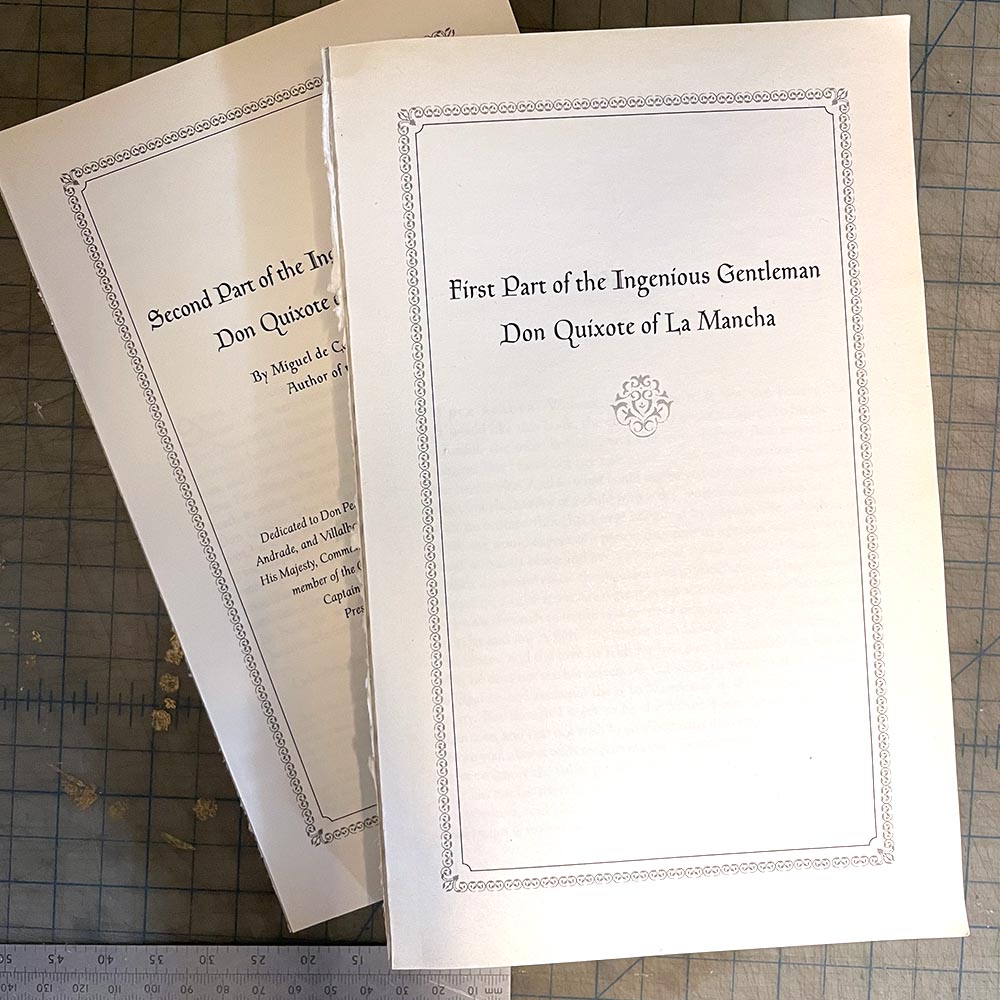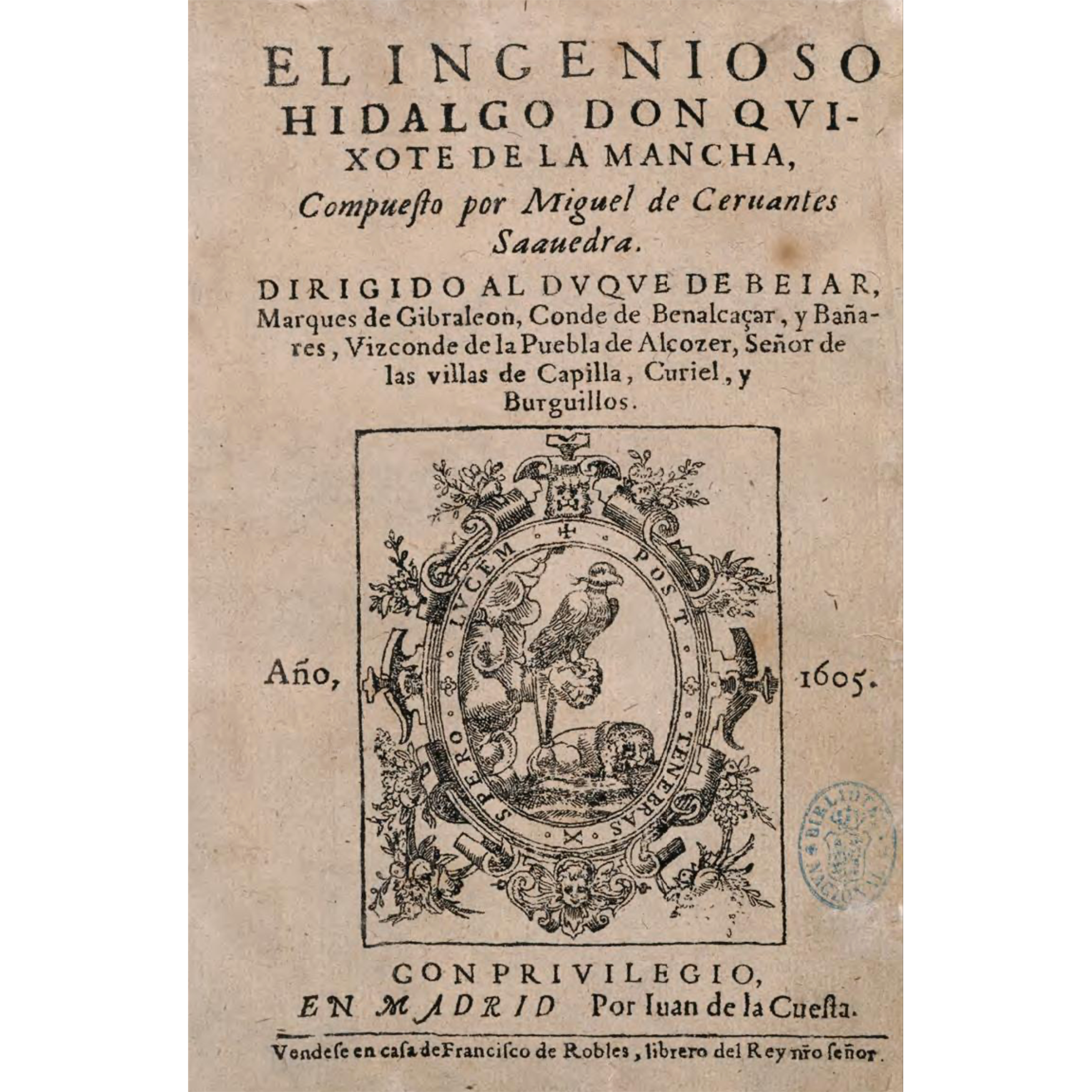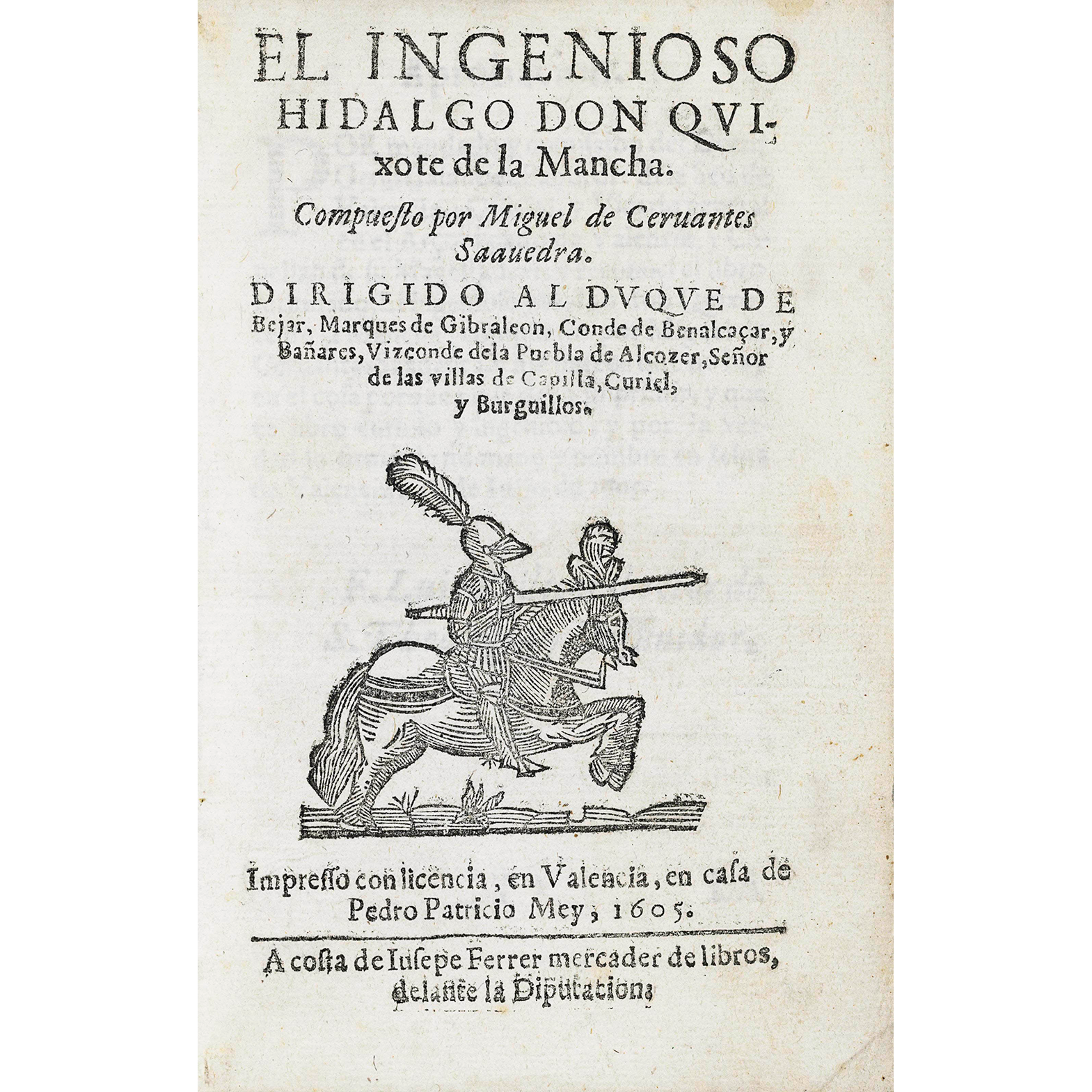Over 500 million copies and 1100 editions have been published; mine’s an English translation from 2005 [↓]:

The Ingenious Gentleman Don Quixote of La Mancha by Miguel de Cervantes recounts the multiple, occasionally pointless and inevitably comedic, adventures of the eponymous gentleman. Alonso Quijano has read too many stories of chivalry which, as a result have caused him to go mad, believing that he should become a “knight errant” just like the protagonists of his treasured books. Quijano changes his name adopting the honorary prefix “Don,” enlists his neighbor Sancho Panza to join him as squire, and sets off to roam the Spanish countryside performing deeds of bravery and nobility for anyone who might (or more often, might not) need his help. The chapters that follow detail Don Quijote’s run-ins with windmills and watermills, with traveling monks, goat herders, enchanted caves, minor royalty, and proper outlaws.
The novel was first published in 1605 by Francisco de Robles of Madrid in a print run of 400 copies. It was an immediate success, reprinted in Brussels, Milan, and Valencia. Here's the title page from 1605 [↓]:

The book‘s success sparked pirate editions. A decidedly unlicensed “sequel” was soon published by a pseudonymous author under the title Second Volume of the Ingenious Gentleman Don Quixote of La Mancha: by the Licenciado (doctorate) Alonso Fernández de Avellaneda, de Tordesillas in 1614.

By this time, Cervantes was already at work on his own legitimate followup [↑] which was published in 1615. In a bracingly modern metafictionalh moment of The Second Part of the Ingenious Gentleman Don Quixote of La Mancha, Cervantes describes his hero wandering in Barcelona and stumbling onto something familiar:

The Ingenious Gentleman Don Quixote of La Mancha by Miguel de Cervantes recounts the multiple, occasionally pointless and inevitably comedic, adventures of the eponymous gentleman. Alonso Quijano has read too many stories of chivalry which, as a result have caused him to go mad, believing that he should become a “knight errant” just like the protagonists of his treasured books. Quijano changes his name adopting the honorary prefix “Don,” enlists his neighbor Sancho Panza to join him as squire, and sets off to roam the Spanish countryside performing deeds of bravery and nobility for anyone who might (or more often, might not) need his help. The chapters that follow detail Don Quijote’s run-ins with windmills and watermills, with traveling monks, goat herders, enchanted caves, minor royalty, and proper outlaws.
The novel was first published in 1605 by Francisco de Robles of Madrid in a print run of 400 copies. It was an immediate success, reprinted in Brussels, Milan, and Valencia. Here's the title page from 1605 [↓]:

The book‘s success sparked pirate editions. A decidedly unlicensed “sequel” was soon published by a pseudonymous author under the title Second Volume of the Ingenious Gentleman Don Quixote of La Mancha: by the Licenciado (doctorate) Alonso Fernández de Avellaneda, de Tordesillas in 1614.

By this time, Cervantes was already at work on his own legitimate followup [↑] which was published in 1615. In a bracingly modern metafictionalh moment of The Second Part of the Ingenious Gentleman Don Quixote of La Mancha, Cervantes describes his hero wandering in Barcelona and stumbling onto something familiar:
As he was going down a street, Don Quixote happened to look up, and over a door he saw written, in very large letters: Books Printed Here, which made him very happy because he had never visited a print shop, and he wished to know what it was like. He went in with his entourage, and he saw them printing in one place, correcting in another, typesetting here, revising there, in short, all of the procedures that can be seen in large printing houses. [...] He moved on and saw that they were also correcting another book, and when he asked its title, they responded that it was called The Second Part of the Ingenious Gentleman Don Quixote of La Mancha, written by somebody from Tordesillas.
"I have already heard of this book," said Don Quixote, "and by my conscience, the truth is I thought it had already been burned and turned to ashes for its insolence; but its day of reckoning will come, as it does to every pig, for feigned histories are good and enjoyable the closer they are to the truth or the appearance of truth, and as for true ones, the truer they are, the better."
And having said this, and showing some signs of displeasure, he left the printing house.Continues in class . . .
September 16, 2024
The Ingenious Gentleman Don Quixote of La Mancha
Reading
A-Man-of-Letters.pdf (Oliver Sacks)
Charlottes-Web.pdf (E.B. White)
Resources
Chapter 1, The Ingenious Gentleman Don Quixote of La Mancha
Chapter 1, The Ingenious Gentleman Don Quixote of La Mancha (manuscript)
Introduction: Don Quijote Sancho Panza and Miguel de Cervantes Saavedra
Type Shop Technician
Peter Kazantsev
The Ingenious Gentleman Don Quixote of La Mancha
Reading
A-Man-of-Letters.pdf (Oliver Sacks)
Charlottes-Web.pdf (E.B. White)
Resources
Chapter 1, The Ingenious Gentleman Don Quixote of La Mancha
Chapter 1, The Ingenious Gentleman Don Quixote of La Mancha (manuscript)
Introduction: Don Quijote Sancho Panza and Miguel de Cervantes Saavedra
Type Shop Technician
Peter Kazantsev